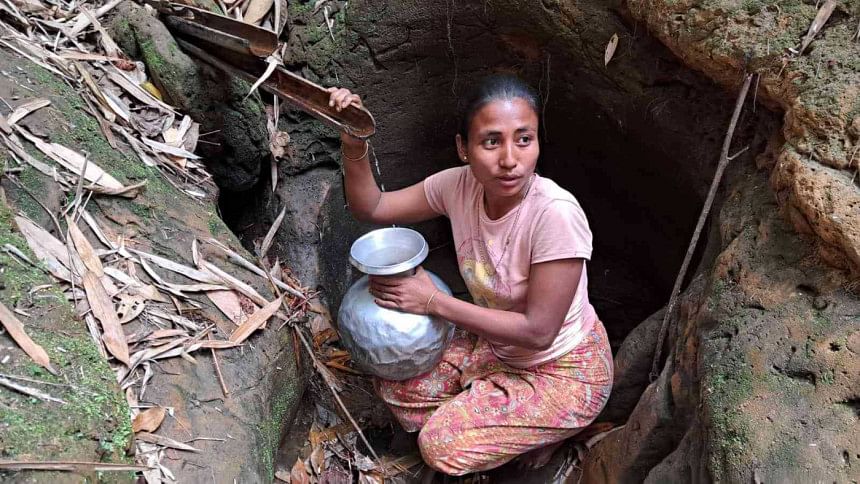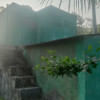Struggling for every drop

As Bangladesh confronts an escalating water crisis, the struggle for safe drinking water is becoming increasingly dire—both in urban centres and remote villages. In Chattogram, rising salinity has rendered water sources undrinkable, leaving residents scrambling for alternatives. Meanwhile, in the hills of Bandarban, villagers endure perilous climbs and hours-long waits for a single jar of water. In Khulna, families from coastal areas have to buy drinking water. These challenges are not isolated incidents but warning signs of a broader crisis that could threaten millions in the years ahead. On this World Water Day, we spotlight harsh realities faced by communities across the country and the urgent need for sustainable solutions.
Residents of Thangkhroi Para, a centuries-old village in Bandarban Sadar upazila, are grappling with an acute drinking water crisis even before the peak of summer.
Their only source of water is a stone pit in a dried-up stream called Thangkhroi, where water trickles down at an agonisingly slow pace. Meanwhile, as the dry season sets in, this meagre supply dwindles further, making survival increasingly difficult.
Home to around 30 families, Thangkhroi Para is a picturesque yet remote village located approximately 15 kilometres from Bandarban town.
Rugged terrain and a lack of proper transportation isolate the community, causing their struggles to go largely unnoticed by authorities, leaving residents to fend for themselves.
CLIMBING HUNDREDS OF FEET FOR WATER
For the women of Thangkhroi Para, collecting water is an exhausting daily battle.
Shainuching Marma, a 40-year-old homemaker, has to climb nearly 500 feet up a steep and hazardous hill daily to fetch water for her family.
After working in the Jhum fields at noon, she returns home to find a shortage of drinking and cooking water, forcing her to make another trip in the evening.
"I can't collect water in the morning because there are too many people waiting in line. We have to go through this hardship every day," said Shainuching.
She also said the crisis extends beyond her village, affecting nearby Upor Buri Para, Niche Buri Para, and Sakkridong Para.
WAITING HOURS FOR A JAR OF WATER
Meching U Marma, 45, and Redama Marma, 55, of the village shared similar struggles.
With the stream nearly dry, they have built a narrow bamboo structure to channel water from a rock cavity. Yet, filling a single jar takes hours.
"Once one person collects water, the next has to wait for a fresh supply. The queue of women collecting water stretches from morning until night," they said.
This same water is used for cooking, bathing, washing clothes, and even for livestock, raising health concerns.
A CRISIS SPREADING ACROSS VILLAGES
A recent visit to the area revealed that the crisis is not limited to Thangkhroi Para. Three other villages -- Upor Buri Para, Niche Buri Para, and Sakkridong Para -- are facing the same dire situation.
Over 200 families, nearly 1,500 people, are struggling without access to safe drinking water, forcing them to rely on unsafe sources.
Maui Aungpru Marma, 56, a resident, said, "Our village has been suffering from a drinking water crisis for a long time. Over the past few years, we have submitted multiple applications to the chairman of the Bandarban Hill District Council for deep tube wells and water reservoirs, but no action has been taken."
"We don't know where else to turn," he said.
Jamchari Union Parishad Chairman Kasing Shai Marma acknowledged the issue.
"Not just Thangkhroi Para, but four other villages in the area are also suffering. We have requested the Public Health Engineering Department and the government to ensure access to safe drinking water," he said.
Contacted, Mohammad Julhaz, assistant engineer of the District Public Health Engineering Department, said, "Between 2022 and 2025, 472 deep wells and 110 ring wells were installed across the district, spending Tk 8.08 crore. However, no plans have been made yet for remote hilly areas."
Meanwhile, Anupam Dey, executive engineer of the District Public Health Engineering Department, pointed out additional challenges.
He said, "Due to the hard rock layer and high iron content in the hills, installing tube wells is difficult. Moreover, deforestation has lowered the groundwater level. However, plans are underway to build surface water treatment plants in some areas."
Rights activist Leluang Khumi highlighted that this crisis in the hilly areas is not new and has been worsening over the years.
"Hundreds of villages in other hilly areas of the district are facing similar water shortages. This problem must be addressed through sustainable development planning. If the authorities do not act soon, the situation will become even more critical," he said.

 For all latest news, follow The Daily Star's Google News channel.
For all latest news, follow The Daily Star's Google News channel. 









Comments